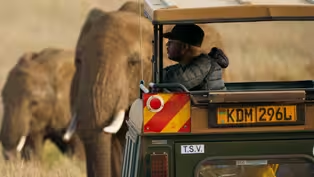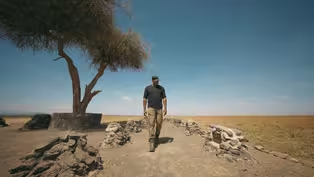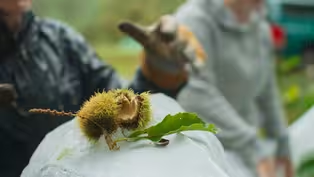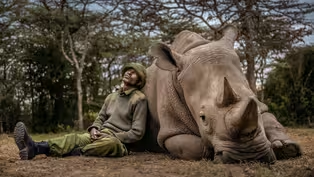
Fossils in the Asphalt: Unearthing LA’s Ancient Past
Clip: Season 2 Episode 6 | 3m 5sVideo has Closed Captions
At La Brea Tar Pits, Emily Lindsey digs into Ice Age life beneath LA’s surface.
Paleontologist Emily Lindsey uncovers the past beneath the streets of Los Angeles at the La Brea Tar Pits — home to the richest Ice Age fossil deposit in the world. Once mined for oil, this sticky site has revealed giant ground sloths, saber-toothed cats, and over five million fossils. It's a fossil jackpot that tells a 40,000-year-old story of life, extinction, and climate change.
Problems playing video? | Closed Captioning Feedback
Problems playing video? | Closed Captioning Feedback

Fossils in the Asphalt: Unearthing LA’s Ancient Past
Clip: Season 2 Episode 6 | 3m 5sVideo has Closed Captions
Paleontologist Emily Lindsey uncovers the past beneath the streets of Los Angeles at the La Brea Tar Pits — home to the richest Ice Age fossil deposit in the world. Once mined for oil, this sticky site has revealed giant ground sloths, saber-toothed cats, and over five million fossils. It's a fossil jackpot that tells a 40,000-year-old story of life, extinction, and climate change.
Problems playing video? | Closed Captioning Feedback
How to Watch Human Footprint
Human Footprint is available to stream on pbs.org and the free PBS App, available on iPhone, Apple TV, Android TV, Android smartphones, Amazon Fire TV, Amazon Fire Tablet, Roku, Samsung Smart TV, and Vizio.
Buy Now

Surprising Moments from Human Footprint
Do you think you know what it means to be human? In Human Footprint, Biologist Shane Campbell-Staton asks us all to think again. As he discovers, the story of our impact on the world around us is more complicated — and much more surprising — than you might realize.Providing Support for PBS.org
Learn Moreabout PBS online sponsorship(mellow music) (Emily) This is my favorite critter here.
This is a giant ground sloth.
(Shane) Yeah, what makes this your favorite?
(Emily) It’s a sloth and it was giant.
(laughter) (Shane) Need you say more?
(bicycle bell rings) Meet paleontologist Emily Lindsey.
Her commute through L.A.’s urban jungle helps her connect with the present... (relaxing music) ...but when she gets to the La Brea Tar Pits, her thoughts turn to the ancient world.
♪ (Emily) This is called a short-faced bear.
(Shane) The idea that there was an animal this large is deeply disturbing to me.
How much bigger is this than, like, a polar bear?
(Emily) A lot.
(laughter) ♪ (Shane) Today, La Brea is almost as iconic as Disneyland or Hollywood, drawing visitors from around the world.
But at the start of the 20th century, people flocked here for another reason.
(Emily) The L.A. basin is the richest oil basin of its size in the world.
In the early 20th century, we were producing about a quarter of the world’s oil.
(Shane) In those days, Rancho La Brea was a rich source of the densest form of crude oil: asphalt.
(Emily) They were digging it up and shipping it up to San Francisco, where it was being used to pave the roads.
(Shane) In some places, finding asphalt didn’t even require digging.
(Emily) And because the other thing we have a lot of in L.A. is earthquakes, there are places where these fissures occur in the ground.
(Shane) Here, the asphalt seeps up to the surface in shallow, sticky pools.
Before long, miners noticed bones-- a lot of them.
They assumed the bones belonged to cattle from the ranch they were digging on until a traveling geologist took a closer look.
(Emily) And he was like, "That’s not a cow bone."
It was the saber of the saber-toothed cat.
Exactly what part of the cow do you think this came from?
(laughing) (Emily) Over time, plants, animals, big, small, get stuck in there.
(Shane) At La Brea, the miners had stumbled onto the world’s largest deposit of Pleistocene fossils-- an entire ecosystem sealed in an asphalt time capsule.
Soon, a new kind of excavation was underway.
(Emily) In about two and a half years, they collected about a million fossils.
Whoa.
(rhythmic music) Is, like, this density, like, normal for the pits?
(Emily) Yeah, it’s just bone on bone, on bone, on bone, on bone.
It makes them really challenging to excavate.
♪ So, imagine playing, pick-up sticks.
But every stick is, like, a different size and shape and also fragile and also priceless.
And then, somebody has dumped a bunch of cement on top of it.
(Shane) In the last century, scientists have excavated over five million fossils here, representing 40,000 years of ecological history.
Video has Closed Captions
Clip: S2 Ep6 | 5m 14s | Kenyan farmers and rangers balance danger and devotion in their fight to coexist with elephants. (5m 14s)
Video has Closed Captions
Preview: S2 Ep6 | 30s | Shane meets species on the brink of oblivion, and the people who won’t let them slip away. (30s)
The Ghost Tree: Bringing Back the American Chestnut
Video has Closed Captions
Clip: S2 Ep6 | 8m 15s | Sara Fitzsimmons fights to resurrect a tree that once ruled the eastern U.S. forests. (8m 15s)
The Northern White Rhino Rescue Mission
Video has Closed Captions
Clip: S2 Ep6 | 11m 4s | Scientists fight to revive the northern white rhino — before it’s too late. (11m 4s)
Orca SOS: Sniffing Out Clues to Save the Southern Residents
Video has Closed Captions
Clip: S2 Ep6 | 3m 7s | Deborah Giles and her dog Eba track whale poop to help save endangered orcas. (3m 7s)
Providing Support for PBS.org
Learn Moreabout PBS online sponsorship
- Science and Nature

Capturing the splendor of the natural world, from the African plains to the Antarctic ice.

- Science and Nature

Explore scientific discoveries on television's most acclaimed science documentary series.
Winnipeg In Bloom











Support for PBS provided by:




